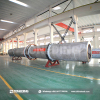10 Questions You Should to Know about Rotary Dryer
What is a Rotary Dryer and How Does It Work?
A rotary dryer is an industrial drying system that uses a rotating drum to remove moisture from bulk materials. The material is fed into the drum, which rotates while hot air is introduced. This process allows for efficient heat transfer and moisture evaporation. Understanding how rotary dryers function is essential for operators to optimize their use and troubleshoot issues that may arise during operation.
What Types of Materials Can Be Dried with a Rotary Dryer?
Rotary dryers are versatile and can be used to dry a wide range of materials, including minerals, aggregates, food products, and biomass. Common materials include sand, clay, wood chips, and grain. Each material may require specific conditions such as temperature, airflow, and drying time, so it’s crucial to select a rotary dryer that fits the material specifications for optimal results.
What Are the Key Components of a Rotary Dryer?
A Rotary Drum Dryer consists of several key components, including the drum, heat source, fan, and discharge system. The drum is where the drying takes place, while the heat source (such as gas burners or hot air) provides the necessary energy to evaporate moisture. The fan circulates the hot air, and the discharge system removes the dried product from the dryer. Familiarity with these components can help in maintaining and troubleshooting the equipment.
How Do You Determine the Right Size of Rotary Dryer?
The size of a rotary dryer is determined by several factors, including the amount of material to be dried, the moisture content of the material, and the desired final moisture content. Calculating the dryer capacity involves understanding the feed rate and the moisture removal rate. Consulting with manufacturers can provide insight into the appropriate sizing for specific applications, ensuring efficient operation.

What Energy Sources Can Be Used for Rotary Dryers?
Rotary dryers can utilize various energy sources, including natural gas, propane, oil, or electricity. The choice of energy source often depends on the availability, cost, and environmental regulations in the area. Each energy source can affect the efficiency of the drying process, so selecting the right one can lead to significant cost savings and improved operational efficiency.
What Maintenance Is Required for a Rotary Dryer?
Regular maintenance is essential for the optimal performance of a rotary dryer. Key maintenance tasks include inspecting and cleaning the drum, checking seals and bearings, and ensuring the heat source is functioning properly. Keeping the dryer free from obstructions and conducting periodic lubrication of moving parts can prevent breakdowns and extend the lifespan of the equipment.
How Do You Troubleshoot Common Rotary Dryer Issues?
Common issues with rotary dryers include inconsistent drying, overheating, and excessive dust generation. Troubleshooting often begins with checking the airflow and temperature settings, as well as ensuring that the material is fed evenly into the dryer. Regular monitoring of these parameters can help identify problems early and maintain optimal performance.
What Are the Advantages of Using a Rotary Dryer?
Rotary dryers offer several advantages, including high efficiency, uniform drying, and the ability to handle large volumes of material. Their continuous operation allows for steady processing, making them suitable for high-capacity applications. Additionally, the ability to adjust temperature and airflow settings provides flexibility in drying various materials, improving overall productivity.
How Can You Optimize the Performance of a Rotary Dryer?
To optimize the performance of a rotary dryer, it’s essential to monitor key parameters such as temperature, airflow, and residence time. Conducting regular performance evaluations and making adjustments based on material characteristics can enhance drying efficiency. Investing in automation and control systems can also improve consistency and reduce energy consumption, leading to cost savings.
When Should You Consider Upgrading Your Rotary Dryer?
Upgrading your rotary dryer machine may be necessary if you experience frequent breakdowns, inefficient drying, or if your production demands have increased. Newer models often come with improved technology that enhances efficiency and reduces energy consumption. Evaluating the performance of your existing equipment and comparing it with modern solutions can help determine the right time for an upgrade.
Conclusion
Understanding the essential questions about rotary dryers can significantly impact their effective use in industrial applications. By knowing how they work, what materials they can dry, and how to maintain them, operators can optimize performance and achieve better drying results. Whether it’s for maintenance, troubleshooting, or considering an upgrade, having the right information is key to successful operation.

